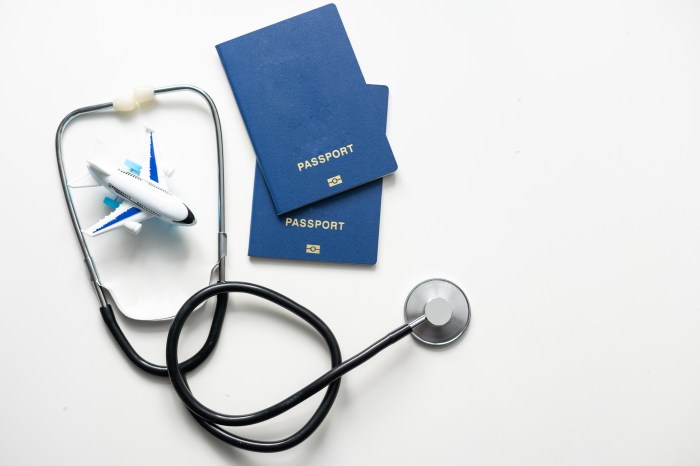
Travel, a thrilling adventure into the unknown, often presents unforeseen challenges. From unexpected illnesses to flight cancellations, the potential for disruption and financial strain is ever-present. This is where travel and medical insurance steps in, acting as a safety net, providing peace of mind, and safeguarding your journey. Understanding the nuances of different policy types, coverage levels, and claim procedures is crucial to selecting the right plan for your specific needs and ensuring a worry-free travel experience.
This guide delves into the essential aspects of travel and medical insurance, exploring various plan types, coverage options, cost considerations, and the claims process. We aim to equip you with the knowledge necessary to make informed decisions, protecting both your health and your finances while exploring the world.
Types of Travel and Medical Insurance

Choosing the right travel and medical insurance is crucial for a worry-free trip. The type of plan you need depends heavily on the length and nature of your travels, your budget, and your individual risk tolerance. Understanding the different options available will help you make an informed decision.
Single Trip Travel Insurance
Single trip insurance covers you for a specific journey with pre-defined start and end dates. This is ideal for short vacations or business trips. Coverage typically includes medical emergencies, trip cancellations, lost luggage, and sometimes even flight delays. Providers often offer varying levels of coverage within this category, impacting the premium cost. Higher premiums usually translate to broader coverage and higher benefit limits.
Annual Multi-Trip Travel Insurance
Annual multi-trip insurance provides coverage for multiple trips within a year. This is a cost-effective option for frequent travelers, offering peace of mind without the need to purchase separate policies for each trip. However, each trip is usually subject to a maximum duration limit, and the total number of days covered annually may be capped. The level of coverage offered mirrors the single-trip plans, with varying options available from different providers.
Backpacking and Adventure Travel Insurance
Backpacking and adventure travel insurance is designed for travelers engaging in higher-risk activities. This type of policy often includes coverage for activities like hiking, skiing, and scuba diving, which might be excluded or only partially covered under standard travel insurance. Premiums are generally higher to reflect the increased risk, and the specific activities covered can vary between providers. Some policies may even require pre-approval for certain activities.
Comparison of Travel Insurance Plan Types
Understanding the differences between these plans is key to selecting the right coverage. The following table summarizes key features:
| Plan Type | Coverage Details | Price Range | Limitations |
|---|---|---|---|
| Single Trip | Covers one specific trip, including medical emergencies, trip cancellations, lost luggage. Coverage levels vary. | Varies greatly depending on destination, duration, and coverage level; generally from $50 to $500+ per trip. | Only covers the specified trip; no coverage for subsequent journeys. Coverage limits apply. |
| Annual Multi-Trip | Covers multiple trips within a year, typically with a maximum duration per trip and a total number of days covered annually. | Generally more cost-effective than purchasing separate single-trip policies for frequent travelers; from $200 to $1000+ annually. | Maximum duration per trip and total days covered annually; specific activity exclusions may apply. |
| Backpacking/Adventure | Covers trips involving higher-risk activities; often includes coverage for activities excluded in standard policies. | Higher premiums than standard plans due to increased risk; from $300 to $1000+ per trip. | May require pre-approval for certain activities; specific activity exclusions and limitations still apply. Higher deductibles are common. |
Cost and Value Considerations

Choosing the right travel and medical insurance plan often comes down to balancing cost and coverage. Understanding the factors that influence premium prices and how to assess the value of different plans is crucial for making an informed decision that suits your individual needs and budget. This section will explore these key considerations to help you navigate the complexities of insurance pricing and coverage.
Factors Influencing Premium Costs
Several factors significantly impact the overall cost of your travel insurance premium. These include your age, the destination of your trip, the length of your stay, and the level of coverage you choose. Generally, older travelers face higher premiums due to increased risk. Destinations with higher medical costs or greater political instability often command higher premiums. Longer trips naturally increase the risk and thus the cost. Finally, comprehensive plans with extensive coverage will always be more expensive than basic plans. For example, a 60-year-old traveling to a high-risk region for three weeks will likely pay significantly more than a 25-year-old traveling to a low-risk destination for a week, assuming similar coverage levels.
Comparing Costs and Coverage Levels
Different insurance plans offer varying levels of coverage, ranging from basic emergency medical expenses to comprehensive plans that include trip cancellations, lost luggage, and other unforeseen circumstances. It’s essential to compare the costs of these different plans side-by-side to understand the value proposition of each. A basic plan might cost significantly less but offer minimal coverage, leaving you vulnerable to substantial out-of-pocket expenses in the event of an emergency. Conversely, a comprehensive plan offers peace of mind but at a higher cost. The key is to find a balance that aligns with your risk tolerance and budget.
Assessing the Value Proposition
Assessing the value of a travel insurance plan requires carefully weighing the potential costs of unforeseen events against the premium cost. Consider the potential financial impact of a medical emergency abroad, trip cancellation, or lost luggage. For example, a medical evacuation can cost tens of thousands of dollars, while a lost luggage claim might only be a few hundred. By comparing the potential cost of these events with the premium cost of a plan that covers them, you can determine if the added cost of a more comprehensive plan is justified by the level of protection it provides. It is often a wise investment to prioritize coverage for major risks over smaller ones, especially for those traveling to high-risk destinations or undertaking adventurous activities.
Comparison of Hypothetical Travel Insurance Plans
| Plan Name | Premium Cost (USD) | Medical Coverage (USD) | Trip Cancellation Coverage (USD) | Lost Luggage Coverage (USD) |
|---|---|---|---|---|
| Basic Plan | 50 | 5,000 | 0 | 250 |
| Standard Plan | 100 | 10,000 | 1,000 | 500 |
| Comprehensive Plan | 200 | 25,000 | 5,000 | 1,000 |
Choosing the Right Plan
Selecting the appropriate travel and medical insurance plan requires careful consideration of several key factors. Failing to do so could leave you financially vulnerable in the event of an unexpected illness, accident, or trip disruption. A well-chosen plan provides peace of mind, allowing you to focus on enjoying your trip rather than worrying about unforeseen expenses.
Key Factors Influencing Plan Selection
Choosing the right travel insurance plan depends heavily on the specifics of your trip. Consider these factors to ensure adequate coverage: your destination’s medical infrastructure and associated costs; the duration of your trip; and the planned activities. A short weekend getaway to a nearby city will have different insurance needs than an extended backpacking trip across Southeast Asia.
- Destination: The cost of medical care varies dramatically worldwide. A trip to a country with advanced medical facilities and high healthcare costs will require a higher coverage limit than a trip to a country with more affordable care. Consider also the political stability and potential for natural disasters in your destination.
- Trip Length: Longer trips naturally require longer coverage periods. Insurance premiums are typically calculated based on the duration of your trip, with longer trips costing more.
- Activities: The type of activities you plan to engage in will impact your insurance needs. Adventure activities like skiing, scuba diving, or trekking often require specialized coverage, which may be an additional cost or require a separate policy. Standard plans may exclude coverage for certain high-risk activities.
Finding Reputable Insurance Providers
Finding a trustworthy insurance provider is crucial. A reputable provider will offer clear and comprehensive policies, prompt claims processing, and excellent customer service.
- Check Reviews and Ratings: Look for independent reviews and ratings from sources like consumer protection agencies or financial review websites. Pay attention to customer experiences regarding claims processing speed and ease.
- Verify Licensing and Accreditation: Ensure the provider is properly licensed and accredited in your country and any relevant jurisdictions. This helps to verify their legitimacy and compliance with industry standards.
- Seek Recommendations: Ask friends, family, or travel communities for recommendations on reliable providers. Word-of-mouth referrals can provide valuable insights.
Importance of Reading the Policy Document
Before purchasing any travel insurance policy, carefully review the entire policy document. This is not simply a formality; it’s a critical step to understanding your coverage.
Thoroughly reading the policy ensures you know exactly what is and isn’t covered, including exclusions, limitations, and claim procedures. This prevents unpleasant surprises and potential disputes later.
Comparing Policies Side-by-Side
Creating a checklist for comparing different policies allows for a systematic approach to decision-making.
| Feature | Provider A | Provider B | Provider C |
|---|---|---|---|
| Coverage Amount (Medical) | $100,000 | $50,000 | $250,000 |
| Trip Cancellation Coverage | Yes | Yes | Yes |
| Emergency Medical Evacuation | Yes | Yes | Yes |
| Pre-existing Conditions Coverage | Limited | None | Limited |
| Premium | $150 | $100 | $200 |
Final Wrap-Up

Ultimately, securing appropriate travel and medical insurance is an investment in a smooth and stress-free travel experience. By carefully considering your destination, trip duration, planned activities, and pre-existing health conditions, you can select a policy that aligns perfectly with your needs and budget. Remember to thoroughly review the policy documents, understand the coverage limitations, and familiarize yourself with the claims process. With the right insurance in place, you can embrace the thrill of adventure knowing you’re protected against the unexpected.
Common Queries
What is the difference between single-trip and annual multi-trip travel insurance?
Single-trip insurance covers a single journey, while annual multi-trip insurance provides coverage for multiple trips within a year.
Does travel insurance cover pre-existing conditions?
Coverage for pre-existing conditions varies greatly depending on the insurer and the specific policy. Some policies may offer limited coverage, while others may exclude them entirely. It’s crucial to disclose any pre-existing conditions when applying.
What documents do I need to file a claim?
Required documents typically include a copy of your policy, proof of the incident (e.g., medical bills, police report for lost luggage), and completed claim forms. Specific requirements vary by insurer and claim type.
How long does it take to process a claim?
Processing times vary depending on the insurer and the complexity of the claim, but generally range from a few days to several weeks.
What activities are typically excluded from standard travel insurance?
Many standard policies exclude high-risk activities like extreme sports, dangerous wildlife encounters, and certain adventure activities. Specialized adventure travel insurance may be necessary for these activities.